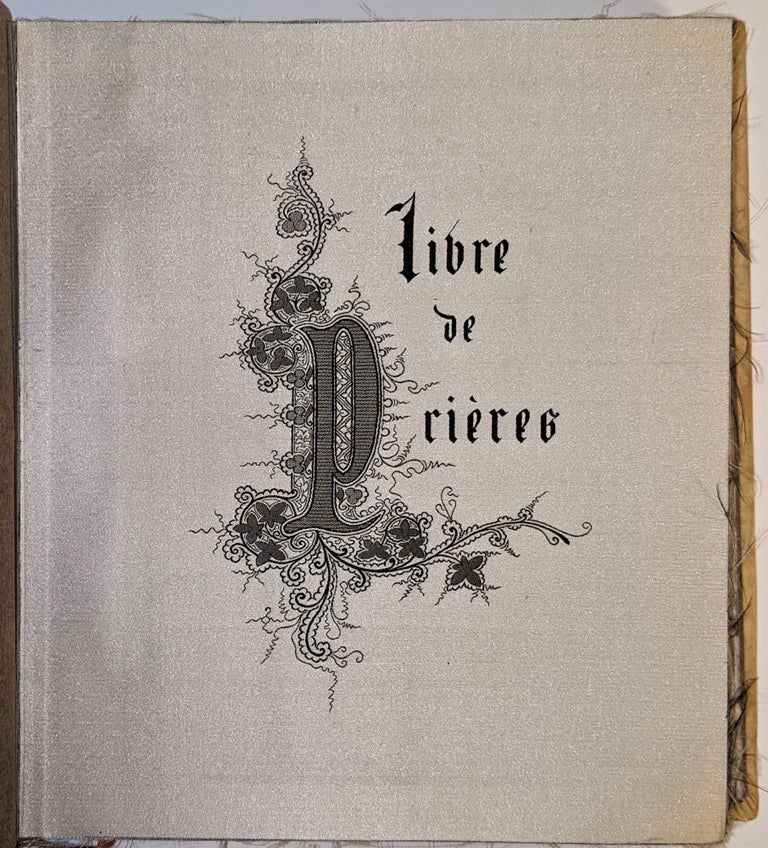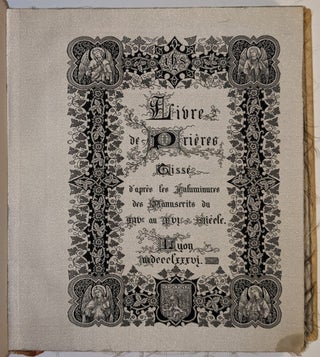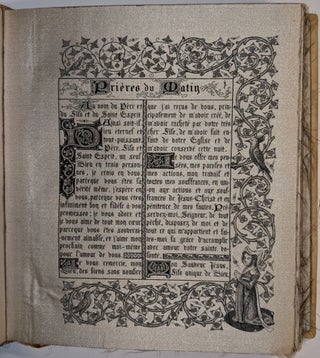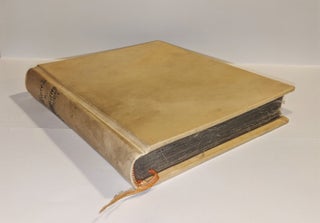Livre de Prières Tissé d’après les enluminures des manuscrits du XIVe au XVIe siècle
Lyon: [R. P. J. Hervier, designer; J. A. Henry, fabricator, for A. Roux], mdccclxxxvi [1886(–1887)]. First edition. Illustrated book on silk, woven in silvery-gray and black threads. Four full-page illustrations, each page within a decorative border in various styles. Ornate initials throughout. Text in Latin and French. In somewhat later vellum, ornate title lettered on spine in black ink. The silk leaves are mounted on gray cardboard. (6) 43 (1) p. Artistically restored. Housed in hard paper slipcase.
The first “computer-printed” book. One of the very few copies of this neo-Gothic book of prayers, woven with punched-card programmed silk loom, developed by Joseph-Marie Jacquard. The only successful example of an entirely woven book. An utmost rarity.
Livre de Prières is one of the earliest book production involving automation and programming and the only example of an entirely woven book. Created in Lyon, the capital of silk, and the hometown of Joseph Marie Jacquard (1752–1834), the inventor of the earliest programmable loom, the machine which is considered an important milestone in the history of computing and the inspiration for Charles Babbage’s Analytical Engine. The Jacquard loom is controlled by replaceable punched cards, fastened together into a continuous sequence, a technique viewed as an early precursor to the computer.
The book was entirely machine woven in silvery-gray and black silk, on such a programmable automated Jacquard loom, by the firm of J. A. Henry. The fabric with the text, illustrations, and the ornaments is so fine, that the programming and weaving took two years and some fifty failed attempts, with a result of approximately only fifty-sixty copies of the faultless book. The operation required several hundred thousand punched cards (estimated between 106,000 and 500,000) to weave four hundred weft threads for every 2.5 centimeters.
Once woven, the silk sheets were folded and mounted on pieces of cardboard to provide the necessary stiffening of the pages. Each copy of the book was custom bound when sold, however many copies remained in stock for years, probably the present copy is one of those, which explains its humble binding.
The illustrations of Livre de Prières came from a late 19th-century monograph Imitation de Jésus-Christ (Paris: Gruel et Engelmann), which contains reproductions of a variety of medieval illuminated manuscripts. The illuminations were chosen by R. P. J. Hervier, who was responsible for the entire design of the volume.
A copy of the book was displayed in the 1889 Lyon Pavilion at the Universal Exposition, where its manufacturer, J. A. Henry, won Grand Prix.
Literature: Marais, P.: Notes sur un livre de prières en tissu de soie. In: Bulletin du Bibliophile, 1889, pp. 163–166.; Randall, L. M. C.: A Nineteenth-Century “Medieval” Prayerbook Woven in Lyon. In: Art the Ape of Nature. Studies in Honor of H. W. Janson. New York: H. N. Abrams, 1981. pp. 651–668.
.
Price: €20,000.00





